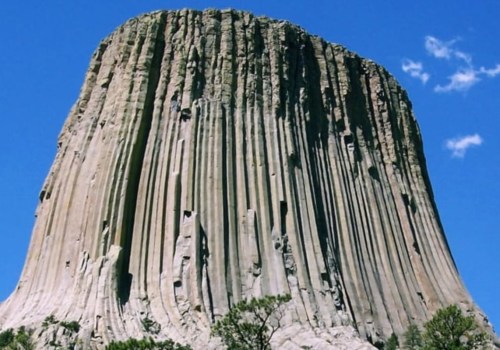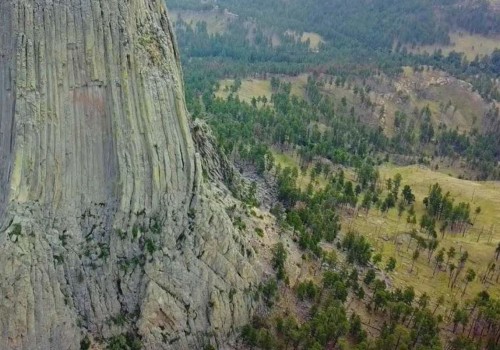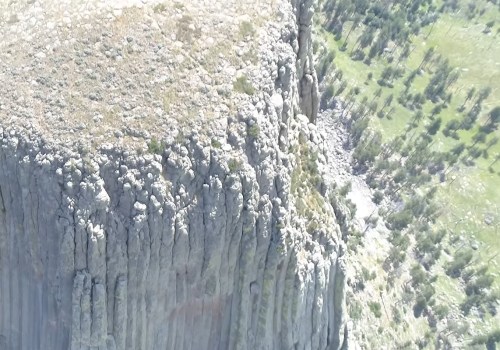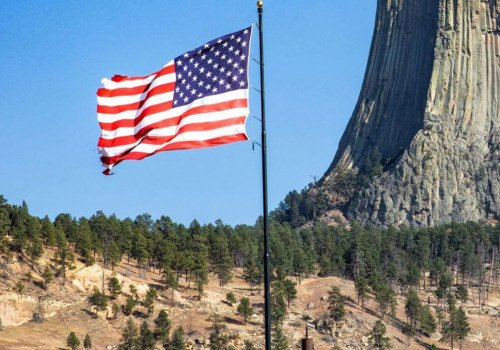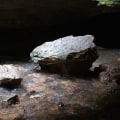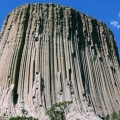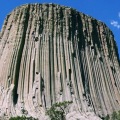Current research suggests that the Devil's Tower was not a volcano, but rather an ancient volcanic plug that was injected between layers of sedimentary rocks and cooled underground. The characteristic furrowed columns are the result of the contraction that occurred during the cooling of the magma. This could explain why the columns of the Devil's Tower are so large. As volcanic rocks slowly cooled, isolated by sediments, large columns could form.
Only subsequent erosion exposed the unusual shape of Devils Tower. However, some mysteries remain surrounding the formation of the columns. The cooling experiments were performed on small samples, only eight inches in length. Geologists are still puzzled by the details that control the formation and pattern of columns in large bodies of volcanic rock.
In nature, joints can form only if the rock is brittle enough and grows over time from cooling from the outside to the still warm and soft inside inside the intrusion. The column joints develop approximately at right angles to the cooling surfaces, which are generally the tops or bottoms of lava flows, the walls of a magma chamber, or a volcanic conduit. In the case of the Devil's Tower, the columns are tilted toward the base, which also suggests that the cooling surface, the walls of the volcanic plug, were tilted outwards. But why the columns become almost vertical, and therefore a challenge for climbers, in the reconstructed core of the Devil's Tower Intrusion is a bit of a mystery.
Geologists assume that tectonic forces and chemical composition of volcanic rocks influence the distribution of heat within the intrusion. As the joints follow isotherms (lines connecting points of the same temperature), perhaps the modern geometry of Devils Tower reflects yet understudied mechanisms of magma placement in Earth's upper crust. Other theories have suggested that Devils Tower is a volcanic plug or that it is the neck of an extinct volcano. Presumably, if Devils Tower were a volcanic plug, any volcanic created by it - volcanic ash, lava flows and volcanic debris - would have eroded long ago. Some pyroclastic materials from around Devils Tower have been identified as being from around its age.
At the time Devils Tower was formed, its surrounding land was almost 915 m (3000 ft) higher than it is today. Magma (molten volcanic rock) was then placed in place underground. After it hardened and cooled, erosion began to take its toll on its surroundings. Assuming similar slow processes we see today, evolutionary geologists believe it took millions of years to expose Devils Tower. The Devil's Tower is said to have been a volcano but was destroyed by an earthquake or possibly even just be a neck of an extinct volcano. The remaining volcano is covered by rock over time.
Geologists agree that Devils Tower began as magma or molten rock buried beneath Earth's surface. The Tower's harder igneous rock is more resistant to erosion and its gray columns began to stand out above its surrounding landscape. Protected in 1906 for its scientific value, Devils Tower remains a place for scientific study and public wonder. Devils Tower is made up of spectacular vertical columns of igneous (volcanic) rock with five or six sides each. As rain and snow continue to erode sedimentary rocks surrounding its base and Belle Fourche River washes away debris, more Devils Tower will be exposed.
The columns rise hundreds of feet in air and extend up to 10 feet wide - truly spectacular! The Devil's Tower is important because it has a very unique appearance and has spiritual meaning for Native Americans. Ironically, erosion exposed by Devil's Tower also erased evidence needed to determine which theory about its formation is correct. The name became popular spot for Native Americans to visit and was eventually renamed Devil's Tower. The oldest rocks visible in Devil's Tower National Monument were deposited in shallow sea during Triassic period - 225 to 195 million years ago. Due to appearance of Devil's Tower surface and surrounding flat landscape, geologists believe that surrounding rock layers were washed away in two separate stages. Thirdly, top of Devil's Tower would be drastically smaller than its base as erosion slowly removed more and more tower.
Many believe molten rock comprising tower may not have surfaced; others are convinced tower is all that remains what was once large explosive volcano. As result gray columns began to appear as isolated mass over landscape. Protected in 1906 for its scientific value, Devil's Tower remains place for scientific study and public wonder.
